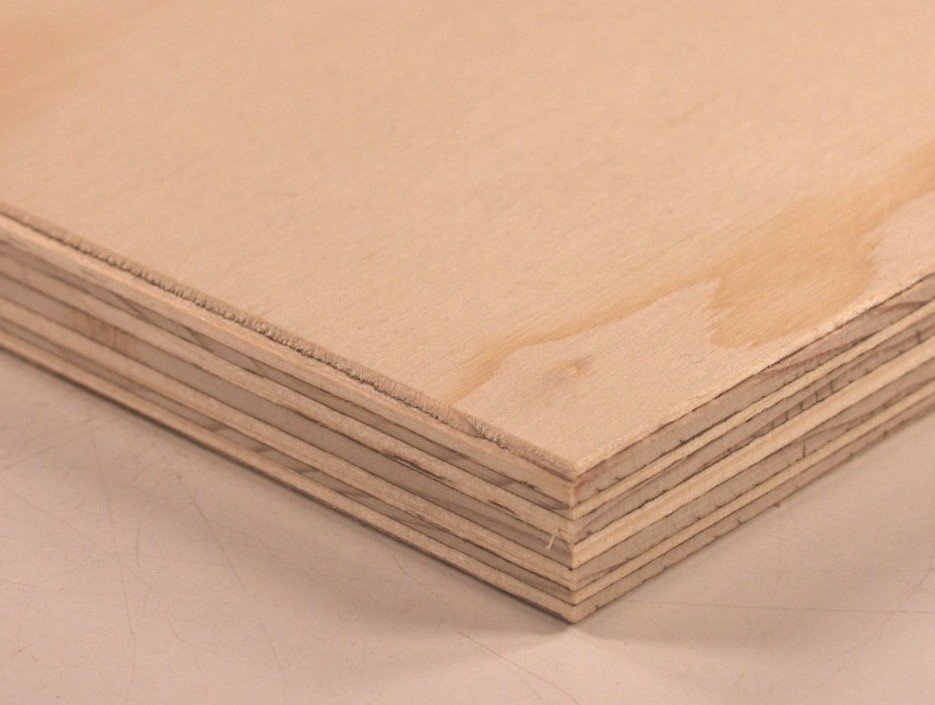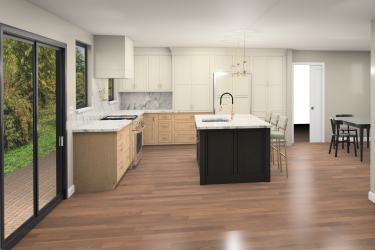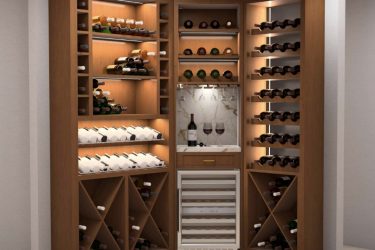Furniture board, particle board, plywood cabinets, oh my! What is best for your kitchen?
When you start a kitchen remodel project, there are a lot of decisions to make! From picking the right appliances and counters to cabinets and colors.
Modern kitchen design offers many options for homeowners. However, one frustrating area is picking the kitchen cabinets.
All cabinets are not equal and installing the wrong ones ruins the look and feel of your kitchen.
This is a major concern for homeowners! Many pros debate over plywood versus furniture board (also known as particle board) for kitchen cabinets.
Three major points we are discussing with the two types of cabinet construction are:
- Cost
- Durability
- Utility
So, let’s take a closer look at plywood and furniture board cabinets and find out which works best for your home.
What is Engineered Wood?
Both plywood and furniture board are considered “engineered wood.”
Engineered wood is “any wood product manufactured by binding or fixing strands, particles, fibers, veneers, or boards of wood together with adhesives or other methods.”
In this article, we are focusing on two specific engineered-wood products – plywood and furniture board.
Did you know that almost all kitchen cabinets are engineered wood?
Pros generally build cabinets using plywood, furniture board, or both.
People often have strong opinions about which is better. This means choosing cabinet materials is stressful, especially if you don’t understand the differences between the two.
Don’t worry – we are here to walk you through the two products and discuss them both!
It is not about finding what is “better,” but about learning which is better FOR YOU and your needs.
Both plywood and furniture board work well as kitchen cabinets. Make the process even easier by knowing the pros and cons of each option.
Also Read:
9 Insider Kitchen Remodel Secrets Revealed
How To Save Big on Kitchen Cabinets
Painted vs Stained Cabinets – How to Compare & When to Use Both
The Difference Between Plywood and Furniture Board
Plywood
Thin layers of wood veneer just 3 millimeters thick form plywood. The pros then glue and bind together the thin layers and compress them with heat making one solid piece of wood. With each new layer, the grain rotates 90 degrees. As a result, it makes for a stronger material with a variety of uses and comes in many different sizes and finishes. Many people think of plywood first when thinking of engineered wood.
Pros and Cons of Plywood
Pros:
- Very strong building material.
- Lightweight yet sturdy.
- Resistant to cracks, warps, and shrinking over time, as well as more moisture-resistant.
- Good for wood paneling, cabinetry, furniture, etc.
Cons:
- Edges of the board are raw and ugly and can’t be covered easily.
- Not suitable for some joints/joining techniques.
- Might have natural defects such as knots from using layers of veneer.

Furniture Board (Particle Board)
Pros create furniture board (also known as particle board) from wood chips, mill shavings, and sawdust bound together with a binding agent such as resin and pressed into flat sheets. It comes in different densities. The higher density products are stronger. Cabinet construction often uses this type of wood because of its lower cost and how it is easy to work with.
Pros and Cons of Furniture Board
Pros:
- Less expensive than many other materials.
- Strong and stable in high-density versions.
- Uniform in texture with no gaps or holes.
Cons:
- Not as strong as plywood, even the high-density versions. Extra supports are needed if heavy countertops are placed over particle board cabinets.
- Less resistant to scratches and dents.
- Not as water-resistant as plywood. (However, neither is waterproof. Any major leakage or flooding ruins either type of wood.)

Many pros advise homeowners that kitchen cabinets should only be plywood. Others insist it’s not a needed expense. The truth lies somewhere in between!
Above all, understanding some of the major concerns with each type helps you pick the right cabinets for your kitchen remodel.
Furniture Board and Water Don’t Mix
Most of the debate over plywood and furniture board comes down to one thing – the two materials behave differently when it comes to water.
If you’ve ever seen furniture board that’s wet for a long amount of time, you’ve seen a swollen, spongy, soft material which crumbles in your hand. In contrast, plywood handles moisture better, though it weakens and deforms over time.
For many, this is the reason for choosing plywood construction. However, they may be overlooking something when making a decision too quickly.
If your kitchen leaks or is flooded, having plywood won’t save you from ruined drywall, flooring, or damaged cabinets. This brings the question of money into play.
Not that plywood cabinets are a waste of money. Certain cabinet components should ALWAYS be plywood because of its moisture resistance. For example, under-sink cabinets should not be furniture board. This area sees more moisture on a regular basis and needs the protection plywood offers.
For areas with lower moisture, furniture board is cheaper and a good option.
Plywood Cabinets for Added Strength
Plywood is stronger than furniture board, and quality plywood cabinets maintain a strength advantage over their lifetime. This means less sagging and deflection over time.
Many homeowners worry about furniture board cabinets being weaker. However, it is still strong enough for use in your kitchen for a very long time.
But if you do opt for furniture board kitchen cabinets, here are some things to know.
Furniture board comes in many densities, and the density relates directly to its strength. High-density furniture board is heavier and stronger than a low-density board. Also, the high-density furniture board holds screw fasteners more securely.
In addition, low-density cabinets do not hold up well over time. If you want the best value from furniture board, do not waste money on a cheap, low-density product. If you do, you get sagging shelves and broken hardware within a few years.
When it comes to cabinet strength, construction and installation are very important.
Even solid wood cabinets won’t be strong if the components aren’t joined correctly. Construction methods matter far more in quality cabinetry than board strength. This is important. Focus on getting well-made kitchen cabinets instead of overthinking the materials.
Note: If you plan to use frameless cabinetry, make sure you only choose high-density furniture board or plywood. Because of the way hardware is mounted on frameless cabinetry, you need the strength and holding ability of high-density material.
A Question of Value – Cost
Where cost is concerned, there is a big difference between the two materials.
Many builders consider plywood cabinets an upgrade in a kitchen build. They charge up to an extra 10 – 20% for them! Many cabinet pros believe this is too high of a price difference. 20 percent more for cabinets is a lot of money when remodeling. As a result, it leaves less money in other parts of your new kitchen design, such as flooring and lighting.
Conclusion
Consider all points above when looking at materials for kitchen cabinets. Also, make sure you understand the pros and cons of different building materials. Consider your design and the functions you want, in addition to cost.
Also, consider your location. Living in a very humid area or one prone to flooding means moisture-resistant plywood cabinets are better. Furniture board cabinets are often better for rental properties or one you plan to remodel again someday.
Talk to a pro and ask questions. Do research!
It comes down to what you value as a homeowner.
Is the added strength and water resistance of plywood worth the cost? Is cost savings a larger factor?
Neither option is a bad choice! It is simply which option suits your needs and your kitchen better.
Looking for a custom kitchen design for your home? Contact Bath Plus Kitchen today!





